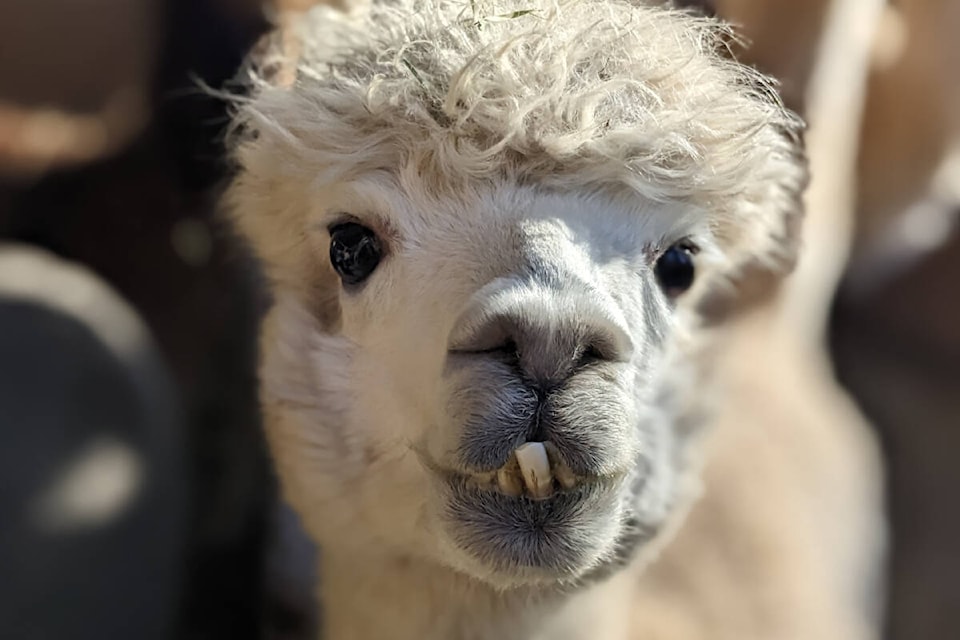Hanahlie Beise took an accidental interest in alpacas. An avid knitter, she’d find herself at farmers’ markets or other farms while travelling, searching for the perfect yarn.
“The alpacas came as a coincidence at the time. There were some that were for sale, and I fell in love with them.”
She purchased the alpacas from a retirement sale, excited to make her own yarn for the various knitting projects she had on the go. Before she knew it, she and her husband, Caleb Beyers, began adopting more animals needing to be rehomed, creating an alpaca and llama sanctuary.
Currently, they have 12 alpacas, one llama and four sheep. They’re also breeding a small flock of Bluefaced Leicester sheep, which provide soft and silky wool.
Beise, originally from Victoria, purchased her property, Hinterland Farm, on Pender Island with her husband in 2018. They moved their animals over from Victoria and began putting fences up and planting a garden. Their property previously had been logged, so much of the couple’s focus has been spent excavating the many stumps, scraping the topsoil, sifting out large stones and planting grass for pastures.
The couple has two young children, and Beise has less time to knit these days. After all, along with raising children, there’s the daily involvement with the animals – feeding them, providing fresh water, mucking and cleaning, she said, her kids in tow.
“[My eldest] was telling his teachers today at preschool about the sheep having babies. It’s fascinating listening to him describe the birth. He’s watched all the animals be born, describing it step by step.”
A few times a year, the animals are sheared, and Beise begins sorting the alpaca fibres into colour groups – her six primary colours being snow, honey, maple, truffle, smoke and ash. Next, the alpaca fibres are washed by blowing them out with a shop vacuum in reverse, pushing the air out. Alpacas love to roll in the dirt, so their fibres can become quite dirty.
As for the sheep, Beise washes the wool in a cold-water bath and then lets it dry out in the sun. From there, she ships everything off to a few different processing plants, where they scour the wool, blend it and put it through a picker, which removes any remaining organic matter. From there, the wool is carded, combing out the fibres to face the same direction. Next, it’s spun into yarn in all different thicknesses. Finally, the yarn is returned to Beise, at minimum, 12 months later. She then sells it through her online shop, Hinterland.
When her kids are a bit older, Beise plans to build her own mill where she can process everything herself.
“I love process-based things, whether growing food or raising animals, something that gives you that slow reward.”
Her mill will allow her to experiment more, pairing different wool blends together, making unique, single-batch yarns more cost-effectively. The yarns she sells are a mix of raw wool from her farm and those sourced from a Hutterite colony.
“I am so excited about the mill … and for our farm to become more of a space that can host people.”
Once her children are both in school, she can focus on the mill and her business full-time while also having flexibility, a crucial characteristic for many working mothers.
In the meantime, Beise is preparing for a group of people partaking in a knitting retreat coming to tour her farm. Although it was expected to rain, which is part of island life, she said.
Hinterland farm has veggie and fruit gardens. The family recently enjoyed bowls of warm chipotle chilli, made with homegrown beans and hominy corn. In speaking with Beise, it’s evident their farm is a cherished home they all love.
“I feel very lucky to be on this property. It’s beautiful. I love our space, our family, the animals.”
Hinterland products and their farm can be found at .
READ MORE:
READ MORE:
Do you have a comment about this story? email:
kim.kimberlin@blackpress.ca



